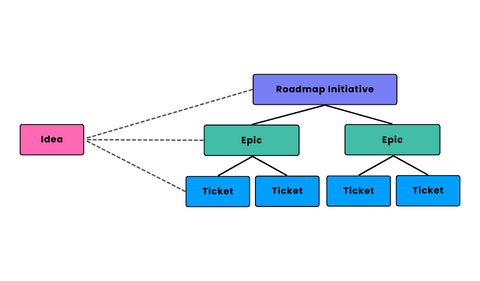Table of Contents
Planning Units of Work
The key units of work in Essembi are roadmap initiatives, epics, tickets and ideas.

Roadmap Inivitiatives
Strategic goals or key projects that align with the overall product roadmap. They represent major milestones or objectives that the product team aims to achieve. Roadmap initiatives help in setting the direction and vision for the product.
Epics
Epics are large bodies of work that encompass multiple tickets. They are a way to group related work together, providing a higher-level view of a set of features or functionalities within a product. Epics help in organizing and prioritizing tasks for better overall management.
Tickets
Tickets refer to individual units of work or tasks. They encapsulate specific issues, features, or enhancements that need attention. They can be assigned, tracked, and managed throughout the entire software lifecycle process.
Ideas
Ideas represent potential features, improvements or innovations suggested by various stakeholders, including team members, customers, prospects or even the market itself. They start as raw feedback that undergo evaluation, refinement and prioritization before being translated into actionable roadmap initiatives, epics or tickets.

Scheduling Components
Once roadmap initiatives, epics and tickets are mapped out, work can be planned using sprints and releases.

Sprints
Sprints are time-bound development cycles, usually lasting a few weeks, during which a set of tickets are worked on and completed. They are part of agile methodologies like scrum and kanban, allowing teams to iteratively deliver functionality while maintaining flexibility.
Tickets are assigned to specific sprints. One of the powerful features within Essembi is the ability to have a ticket span across multiple sprints with estimated points assigned to each sprint.
Releases
Releases mark specific points in time when new versions or updates of the product are made available to users or clients. Each release includes a set of tickets that have been completed within the sprint or development cycle.
Other Key Data Structures Available in Essembi
Contacts (Customers / Prospects)
Set of customers and prospects that can be assigned to other data components. For example, tickets can have assigned customers or prospects. This data relationship helps segment tickets by customer and more throughout Essembi.
Competitors
Understanding competitor landscape aids in making informed decisions about feature prioritization, market differentiation and overall product strategy. Essembi enables you to gather and track intelligence about rival products - their features, strengths, weaknesses, market positioning and strategies.
Go-To-Market Tasks
These tasks are associated with the activities required to launch a new product, a major release or a minor release successfully. They encompass activities such as marketing campaigns, sales enablement, documentation, training and other preparatory actions needed to introduce the product to the market and ensure its adoption.
